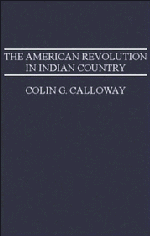Book contents
- Frontmatter
- Dedication
- Contents
- List of figures and maps
- Preface
- Acknowledgments
- Abbreviations
- Prologue New worlds for all: Indian America by 1775
- 1 Corn wars and civil wars: the American Revolution comes to Indian country
- 2 Odanak: Abenaki ambiguity in the North
- 3 Stockbridge: the New England patriots
- 4 Oquaga: dissension and destruction on the Susquehanna
- 5 Fort Niagara: the politics of hunger in a refugee community
- 6 Maquachake: the perils of neutrality in the Ohio country
- 7 Chota: Cherokee beloved town in a world at war
- 8 Tchoukafala: the continuing Chickasaw struggle for independence
- 9 Cuscowilla: Seminole loyalism and Seminole genesis
- 10 The peace that brought no peace
- Epilogue A world without Indians?
- Index
5 - Fort Niagara: the politics of hunger in a refugee community
Published online by Cambridge University Press: 18 December 2014
- Frontmatter
- Dedication
- Contents
- List of figures and maps
- Preface
- Acknowledgments
- Abbreviations
- Prologue New worlds for all: Indian America by 1775
- 1 Corn wars and civil wars: the American Revolution comes to Indian country
- 2 Odanak: Abenaki ambiguity in the North
- 3 Stockbridge: the New England patriots
- 4 Oquaga: dissension and destruction on the Susquehanna
- 5 Fort Niagara: the politics of hunger in a refugee community
- 6 Maquachake: the perils of neutrality in the Ohio country
- 7 Chota: Cherokee beloved town in a world at war
- 8 Tchoukafala: the continuing Chickasaw struggle for independence
- 9 Cuscowilla: Seminole loyalism and Seminole genesis
- 10 The peace that brought no peace
- Epilogue A world without Indians?
- Index
Summary
The role of Fort Niagara as a frontier outpost and headquarters for British and Indian operations against the American frontier is well known. Preoccupation with the military activities at the fort, however, obscures the complex nature of the society that developed there during the Revolution. One of the “upper posts,” along with Detroit and Michilimackinac, Fort Niagara in the Revolution was a military headquarters, a trading post, a supply depot, a diplomatic hub, and a multiethnic, multiclass society. Indian people who had lost everything in the war became increasingly dependent on the patronage of their allies at the fort. It emerged as a new community of peoples displaced from America by the chaos of war, and served as a conduit for the formation of other new communities in Canada. It was also a community whose communication with Quebec took six weeks when navigation was open, and that was sometimes totally isolated in winter. The composition and isolation of the community created a situation in which competition for wealth and power flourished in the midst of misery and hunger.
As Laurence Hauptman and Richard White have shown, the refugee experience was nothing new for native peoples in northeastern North America. Iroquois villages took in people seeking shelter under the Great Tree of Peace, and in the eighteenth century, Conoys, Housatonics, Mahicans, Miamis, Mohegans, Montauks, Nanticokes, Narragansetts, Saponys, Shawnees, Susquehannocks, Tuscaroras, Wappingers, Esopus, and various remnants of New England tribes found refuge in Iroquois villages along the upper Susquehanna Valley and in the area south and west of the Mohawk Valley. In many ways the Iroquois were the true assimilationists of early America. Many of the people who fled to Fort Niagara in the Revolution were themselves refugees, or the children of refugees, who had fled to Iroquoia and been incorporated into the Iroquois world. The difficulties of adjusting to new homes, living alongside other refugees, and of coping with social disruption and elements of dysfunctional behavior were not new to these people.
- Type
- Chapter
- Information
- The American Revolution in Indian CountryCrisis and Diversity in Native American Communities, pp. 129 - 157Publisher: Cambridge University PressPrint publication year: 1995



